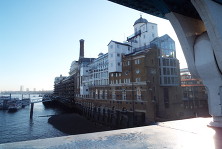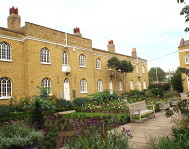








Borough Market
Borough Market, like its neighbour Southwark Cathedral, is a remarkable survivor with a long history. Though it is London’s oldest fruit and vegetable market, it has constantly adapted to the changing times and environment, and today is a vibrant, very popular market that offers a wide choice of the high quality British and international produce to retail customers, a foodie's paradise.
The market dates back to the eleventh century. By the sixteenth century it was under the jurisdiction of the City of London who received the profits. The market took place at the north end of Borough High Street where stalls were set up on both sides of the road from the foot of London Bridge to St Margaret’s Church (now the site of the Slug and Lettuce). Goods on sale included fish, meat, poultry, oats, barley, flour, fruit and vegetables. A Market Bailiff inspected the foods for quality and also enforced prices.
Market days were busy and crowded and caused congestion for the through traffic – carts, animal and human - to and from London Bridge and in 1624 there were calls for the market to be relocated. The City were unwilling at that time to move the market but introduced regulations in the hope of improving the free flow of traffic. Stalls were only to be set up on the west side and to keep clear of the gutter that ran down the centre of the road. Stalls were now allocated precise locations where they were to set up and trade based on the produce that was being sold. Women who sold goods from baskets were ordered to keep on the move rather than to sit down in one location.
Congestion though still continued to be a problem but it was not until 1755 that the City of London were willing to forego the profits from the Market when an Act of Parliament was passed that banned the market in Borough High Street. A year later a second Act of Parliament empowered the Churchwardens, Overseers and eleven of the most substantial parishioners of St Saviour’s to purchase a designated piece of land and to raise £6000 by the selling of annuities to pay for the land and buildings for a new relocated market. Any surplus after paying expenses and annuities “remain an estate for the use and benefit of the said parish for ever, and shall and may be applied in diminution of any of the parochial rates or assessments.” The Act made it an offence to sell provisions by hawking, that is selling from a temporary stall, within a thousand yards of the market.
The land purchased for the new market was referred to as The Triangle and still represents approximately the centre of the current market. Parcels of the required land were compulsorily purchased and materials contained in houses scheduled to be demolished were sold and taken away, and arrangements made for the paving of the area.
In February 1756 and advert was placed in newspapers announcing the new market would be ready on 25 March and that the market would not continue in Borough High Street after 26th March. A Clerk of the Market was appointed to collect the rents and a piece of ground next to St Mary Overie Stairs purchased to provide a wharf for those wishing to bring produce to market via the River. Arrangements were made for nine lamps to be lit “from when it gets dark to daylight” for eight months of the year after complaints from stallholders. It was ordered the Clerk of the Market was to ring the market bell every morning at 9 o’clock and that that stalls were not to be set out until the bell had stopped ringing. In 1758 part of the market was set aside where a Corn Exchange was built for buying and selling all sorts of bran, grain and oatmeal.
By the early 1770s the new market was well established and successful, and beginning to make a good surplus. The market Trustees were able to give £1,500 towards the building of the new Workhouse in 1776. In 1787 and 1789 the Parish of St Saviour’s made representations to the Trustees that the Poor Rates raised were insufficient to meet the needs of the Poor in the Parish and both times the Trustees agreed to make a payment of £500 to the parish.
Then, in December 1789, a newspaper advertisement was presented to a meeting of the Trustees whereby it was announced that James Hedger wished to inform the public that St George’s Market, located in London Road, St George’s Fields, would be opened shortly “with a plentiful choice of all sorts of provisions.” James Hedger was the proprietor of the notorious Dog and Duck (now the site of the Imperial War Museum), a tavern that had acquired a dubious reputation, and had recently been refused a licence by the Surrey Magistrates. The Committee and Trustees of Borough Market were outraged and though clear St George’s Market was outside of the 1000 yard boundary and only a small enterprise, they maintained that the Act prohibited all markets in the Borough of Southwark.
Legal proceedings were instigated and James Hedger pleaded he knew nothing of this part of the Act and offered to pay £20 per annum for a license to trade. The Trustees refused and, at a subsequent Court hearing, judgment and costs were made for the Borough Market Trustees. It appears that this ruling was not enforced and St George’s Market still continued to trade, and the Borough Market Trustees in August 1790 sued James Hedger for £2000 damages. The Times reported that as 6,000 houses had been built nearby in the last three years, and more were being built, the jury deemed the new market useful and awarded only one shilling damages.
In the middle of the nineteenth century, Borough Market was to change dramatically. A bill was put before Parliament in 1858 by the Charing Cross Railway Company seeking to build extensions of the railway line from London Bridge into Charing Cross and Cannon Street. The new lines were to run on viaducts which it was proposed to run right over Borough Market and provision was made in the Bill for the compulsory purchase of the land required. The Borough Market Trustees petitioned Parliament against the Bill, nevertheless the Bill became law with some amendments including a clause that the new railway tracks were to be supported over the market on cast iron pillars rather than on brick viaducts. Once the project got underway and it was expedient for the Charing Cross Railway Company to have the co-operation of the Borough Market Trustees to prevent delays, the Trustees negotiated hard to obtain “what property and other return the Company were prepared to offer the Trustees.”
By the terms of the original Act of Parliament, Borough Market was unable to sell any of its land so the railway were only able to acquire the land necessary for the foundations of the iron pillars leasehold. Borough Market’s surveyors valued the Market’s land which was to be compulsorily leased and the related damage at £13,500. The Trustees put in a claim for £14,750 and the final agreed figure was £14,000. The market demanded the company buy additional land and present it to the market as compensation for damage caused by the building of the new line. The railway company acquired a smaller area of land and gave it to the Market. When however the Market requested compensation from the railway company for building brick piers on this newly acquired land, the Company refused. In a meeting of the Market Trustees, it was decided to accept this “upon the express understanding the Company shall deal liberally with respect to the contribution to the expenses of a new roof to the old market” and that the Company should make other concessions. The construction of a new roof, which was necessary as a result of the railway works, was estimated at a cost of £3,000. The plans were submitted to the Charing Cross Railway Company with an estimate of £4,000. The Company offered £2,000 on condition the Trustees did not press for the additional concessions. The final figure agreed as the Company’s contribution to the new roof was £2,250.
So the Borough Market Trustees turned a crisis into an opportunity by expanding the market and paid for in a very large part by the railway company. Similar though smaller negotiations were conducted twice more in the nineteenth century as it became necessary to carry out more work on the railway. The London Bridge to Charing Cross Railway opened in 1864 and the appearance and the sound of the market changed forever from being an open air market to one that sheltered in the dark beneath noisy railway arches.
Nearly a hundred and fifty years later, there have again been major engineering works as it has become necessary to build a further bridge over the market to carry two more tracks to ease the bottleneck of trains in and out of London Bridge Station. This has entailed some demolition of the market and surrounding property, and a new glass hall fronting onto Borough High Street has been erected.
The market underwent a transformation at the end of the 20th century in keeping with the whole revival of Bankside and an out of the way fruit and vegetable wholesale market regenerated into the bustling destination food market it has become today. 'Designed Renewal at Borough Market' by Susan Parham describes the process.
The Market is still run by a Board of Voluntary Trustees with local connections, and any surplus is passed to the London Borough of Southwark for the benefit of residents of St Saviour’s Parish. And still the Trustees guard the Market's monopoly jealously. In 2011 the nearby Vinopolis applied to the Council for planning permission to use part of its yard as a small wine and food market. The Market raised objections that it would fall within the prohibited 1000 yards as defined by the 1756 Act and the application was withdrawn.
Sources
Thomas Allen, The History and Antiquities of London, Westminster, Southwark and Parts Adjacent (Vol 4), 1839
Martha Carlin, Medieval Southwark, 1996
Matthew Concanen and Aaron Morgan, The History and Antiquities of the Parish of St Saviour's, Southwark, 1795
David Johnson, Southwark and the City, 1969
The Times: 3 August 1790
LMA: Minutes of the Trustees of Borough Market ACC/2058/1/18, 19. 25 & 26
Web discoveries
- UK Casino Not On Gamstop
- UK Casino Not On Gamstop
- Non Gamstop Casino
- Casinos Not On Gamstop
- Non Gamstop Casinos
- Non Gamstop Casinos
- Non Gamstop Casino
- Casinos Not On Gamstop
- Casino Sites Not On Gamstop
- Slots Not On Gamstop
- Casinos Not On Gamstop
- UK Betting Sites Not On Gamstop
- UK Casino Not On Gamstop
- Best Non Gamstop Casinos
- Betting Sites
- Non Gamstop Casino Sites UK
- Best Non Gamstop Casinos
- Non Gamstop Casino
- Casinos Not On Gamstop
- Non Gamstop Casino Sites UK
- Horse Racing Betting